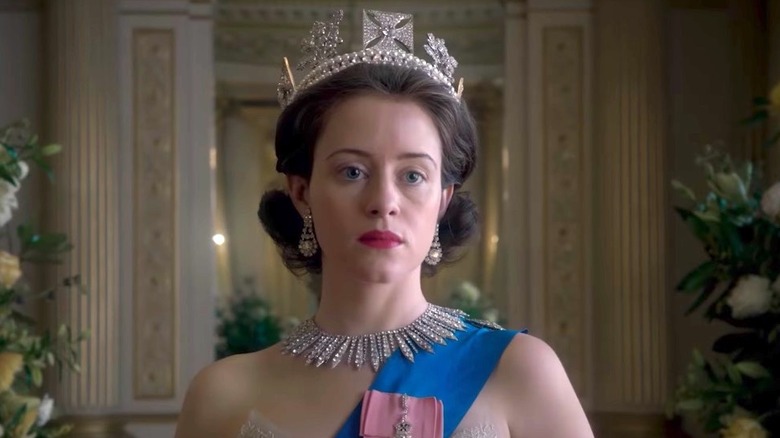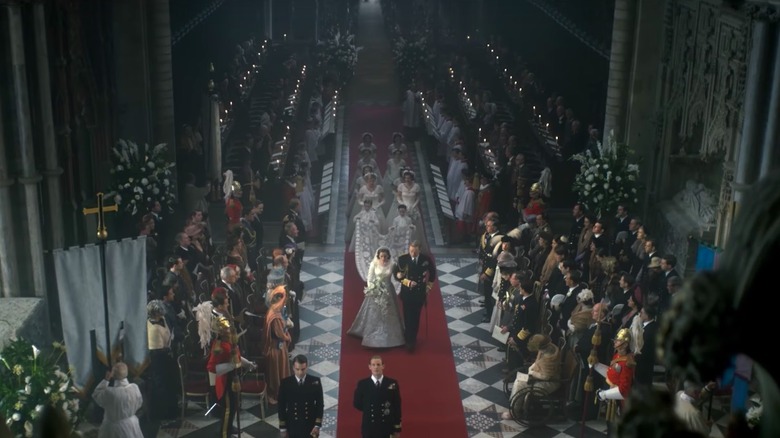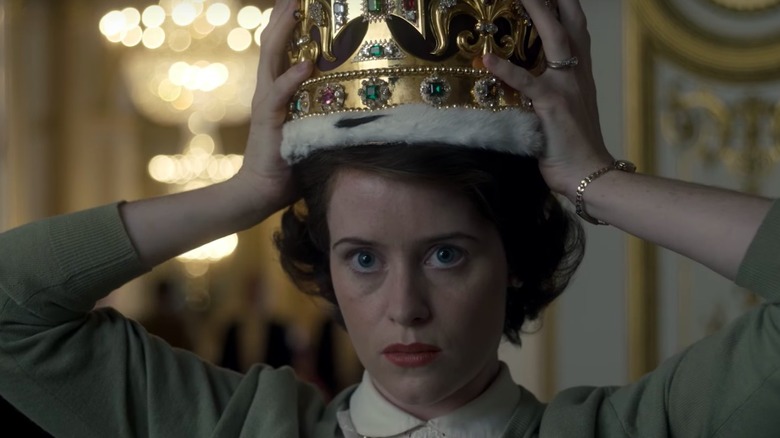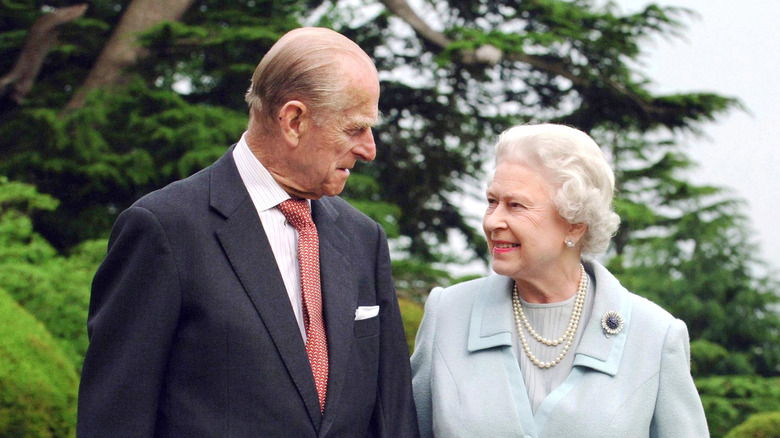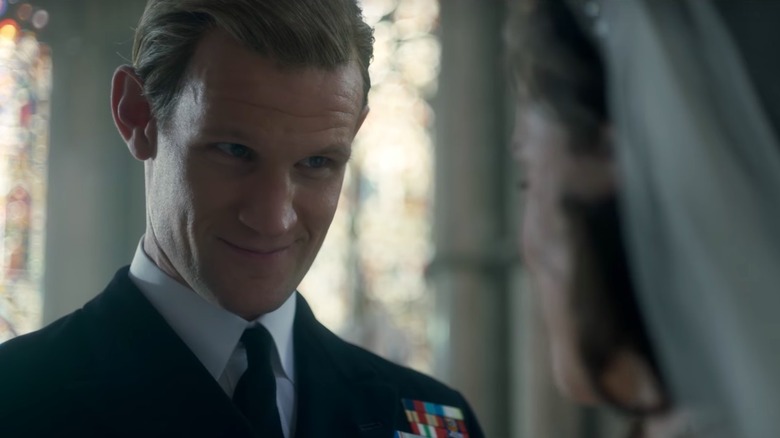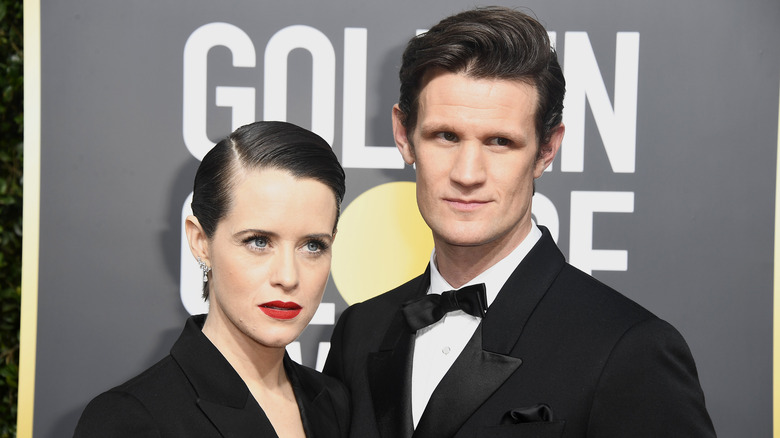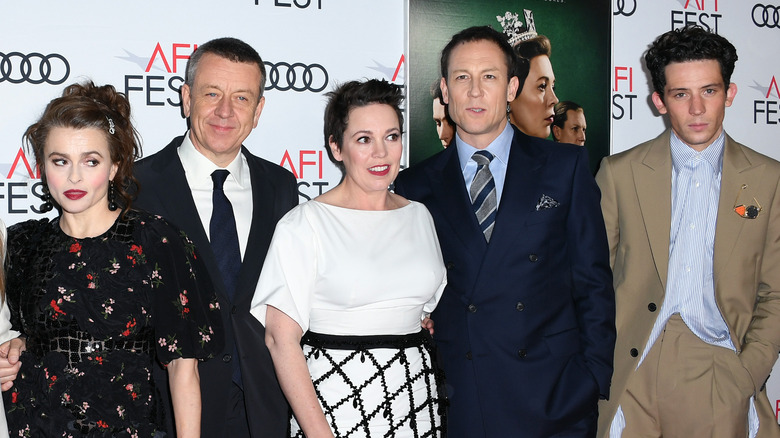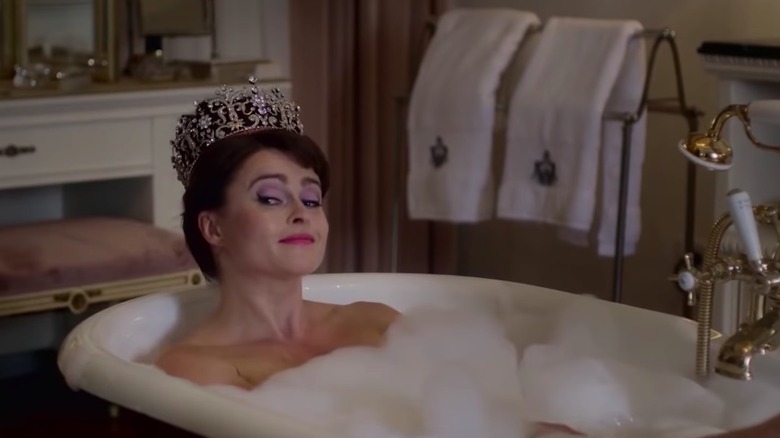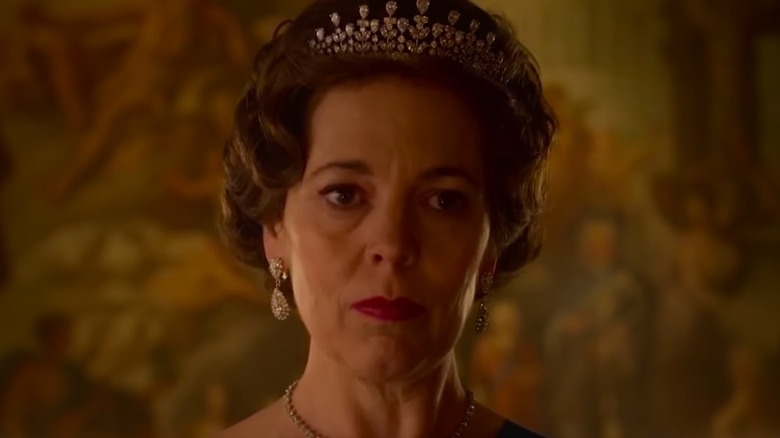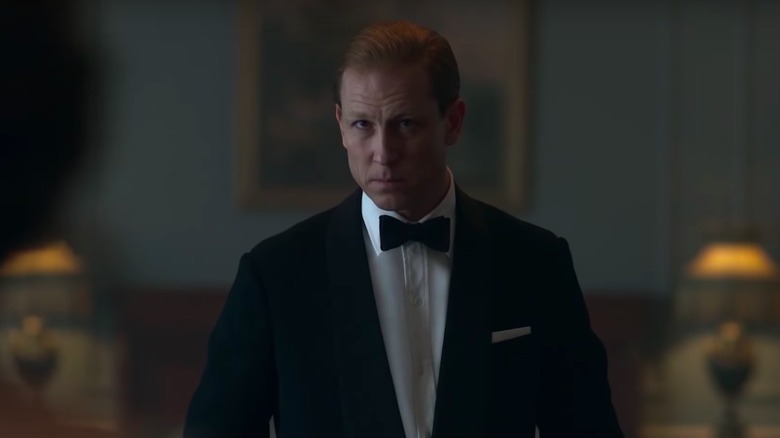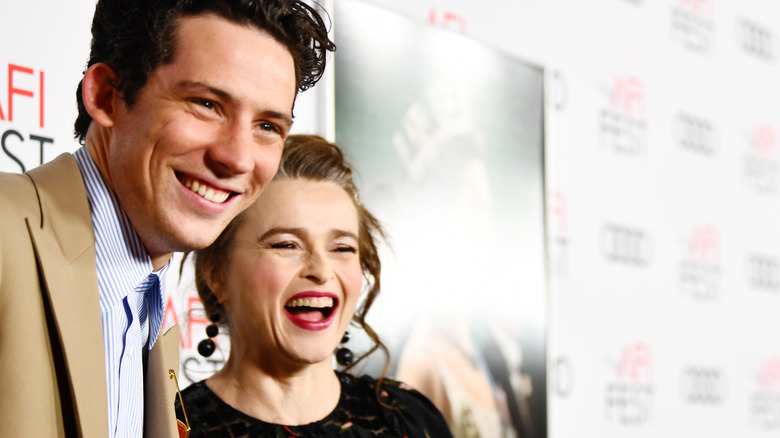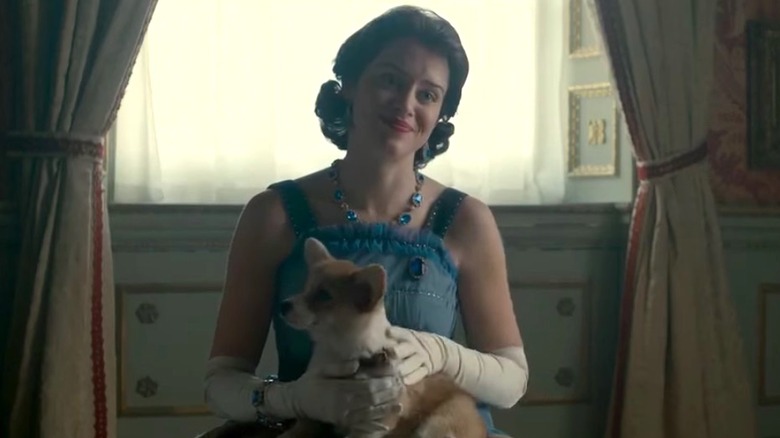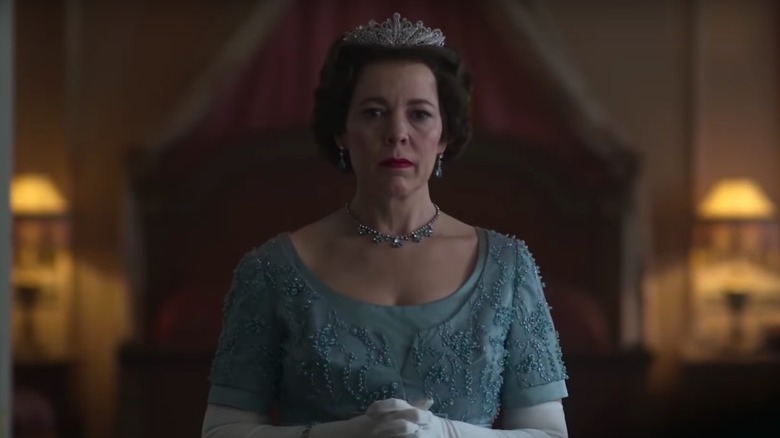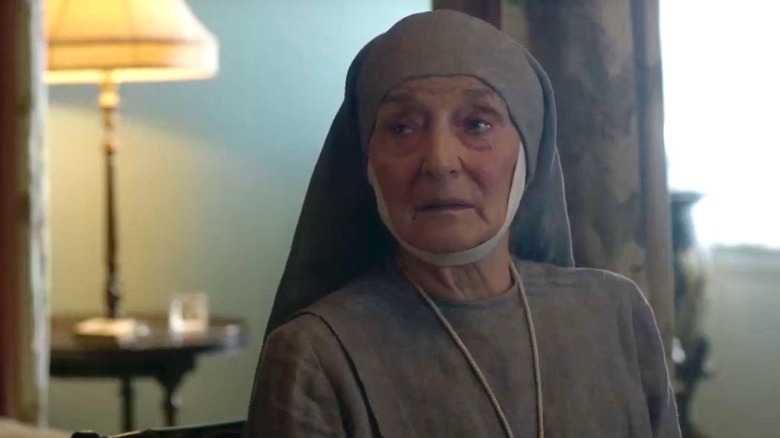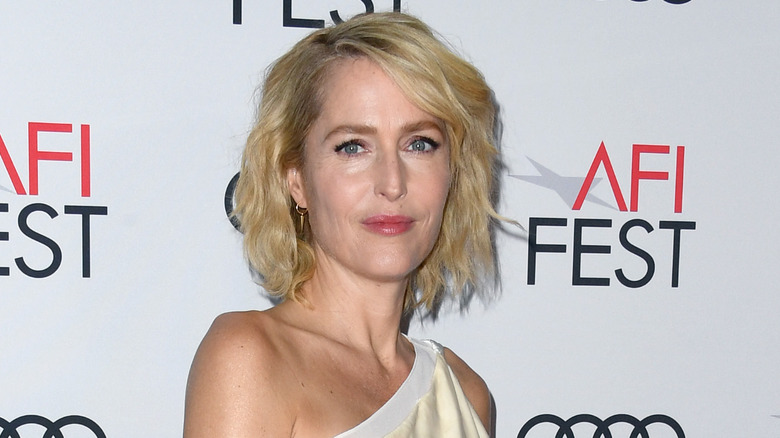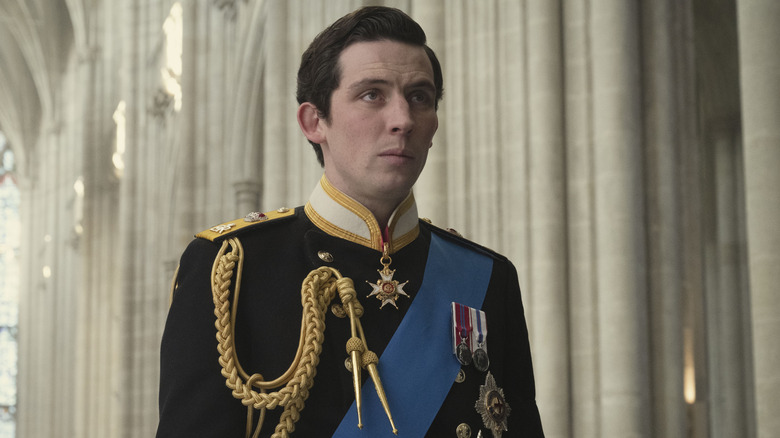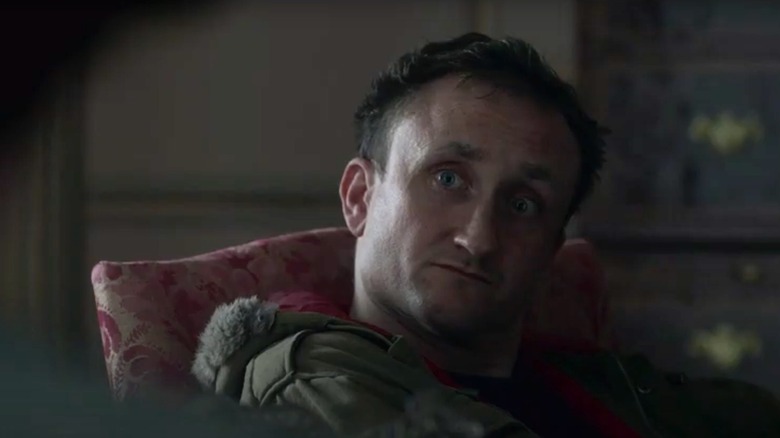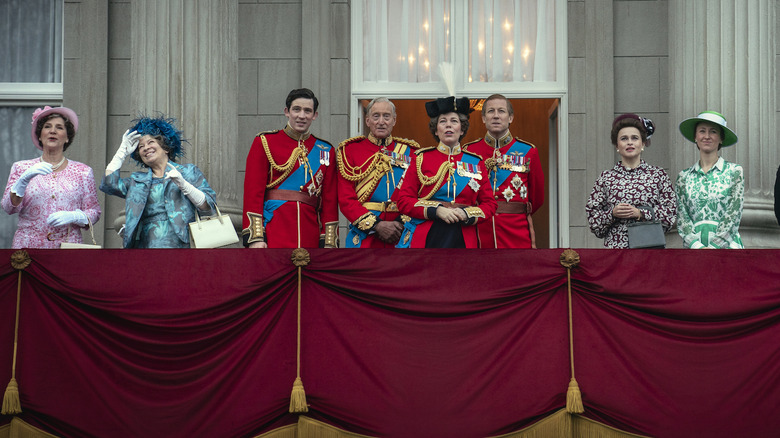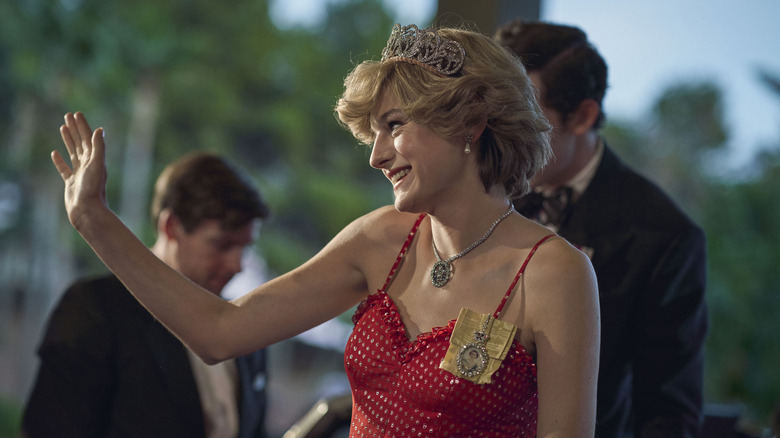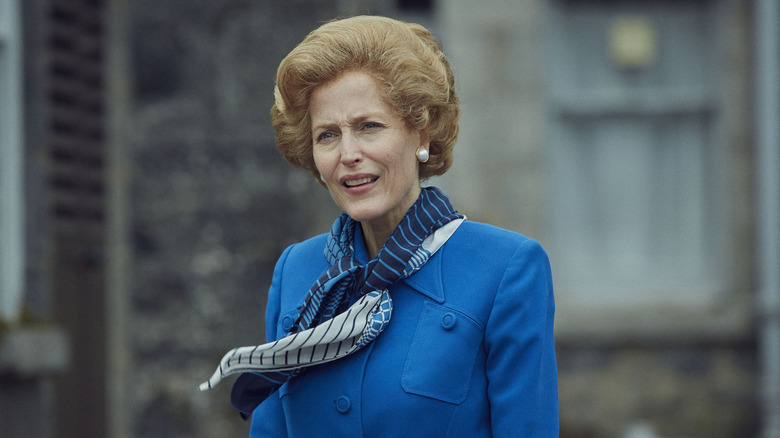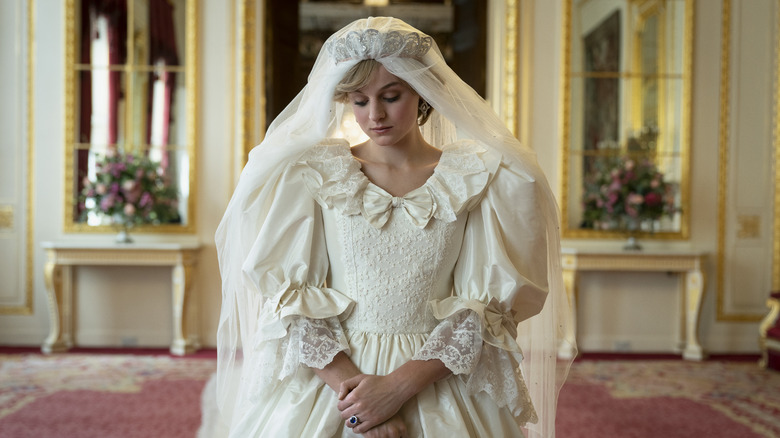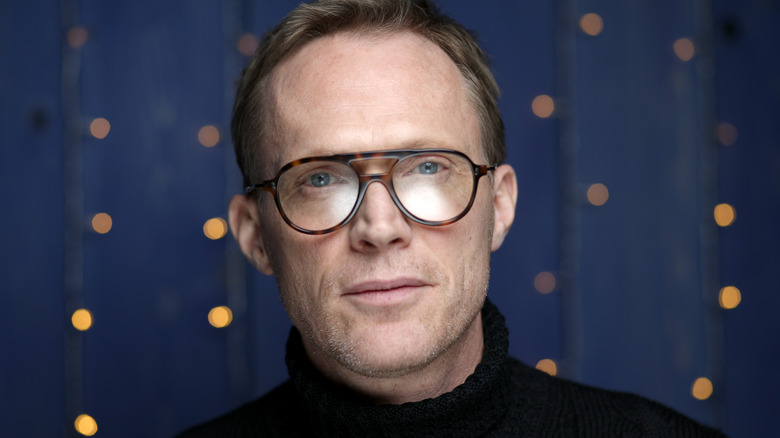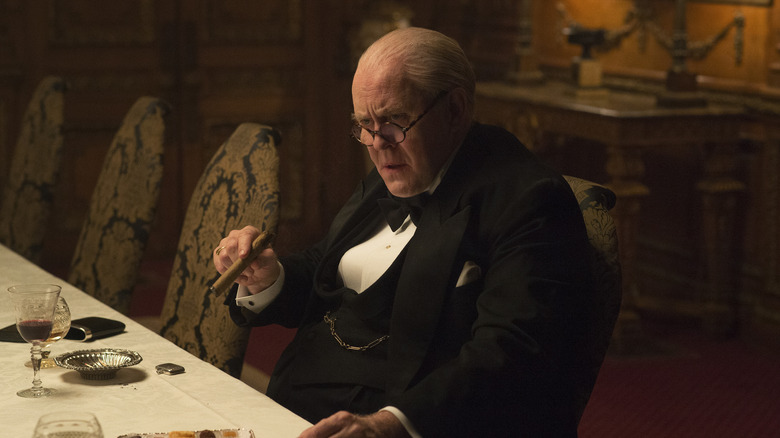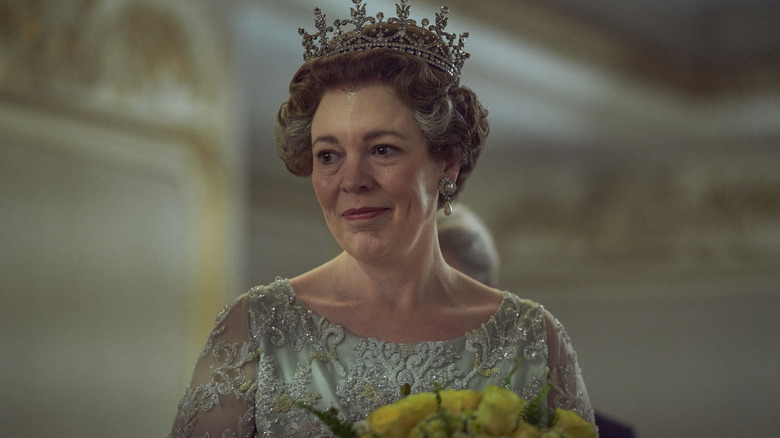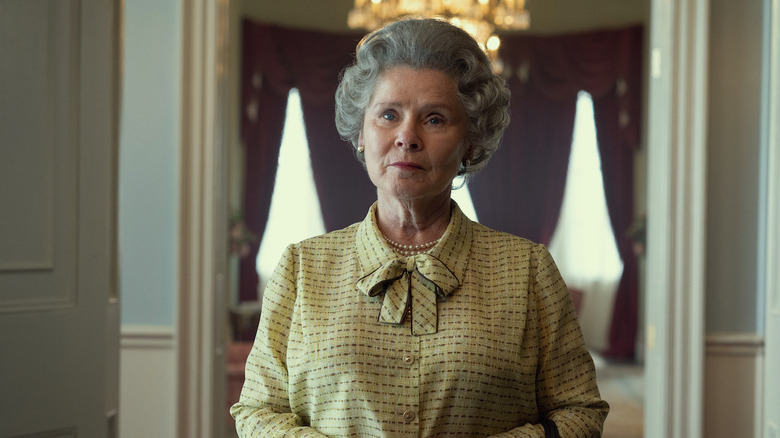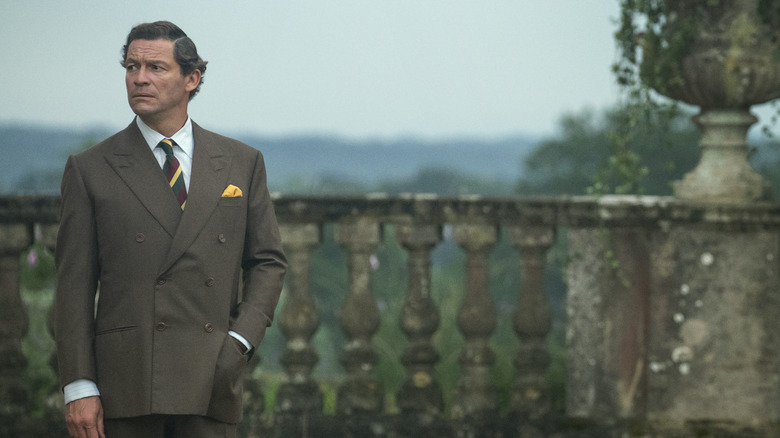The Untold Truth Of Netflix's The Crown
Netflix's "The Crown" was announced in 2014, as reported by BBC News. The streaming giant revealed their plans for an ambitious TV series dramatizing the stunning transformation of Queen Elizabeth II. Written and produced by Peter Morgan (who also dramatized Her Majesty in the 2006 film "The Queen"), the big-budget show would chronicle the queen's extraordinary reign after being thrust upon the throne at age 25.
Eventually, more news emerged. British actress Claire Foy was cast as Elizabeth, while "Doctor Who" star Matt Smith would portray her husband, Prince Philip. And John Lithgow was tapped to play Sir Winston Churchill. "Elizabeth II is a unique prism through which to look at the second half of the 20th century," Morgan told The Telegraph of his vision for the show. "She is a protagonist with a predicament that none of us can really imagine, and that is the side I've explored in this — to what degree does this enormous change in your life change all your relationships, the family power structures?"
This is the untold truth of Netflix's "The Crown."
Is Netflix's The Crown really the most expensive series in TV history?
As "The Crown" went into production, reports emerged about the show's gargantuan budget, a testament to Netflix's commitment to getting every detail correct in what promised to be one of its marquee shows. As The Daily Beast reported, the show's alleged $130 million budget made it the most expensive television show in the history of the medium. But was it?
In a subsequent interview with Express, series creator Peter Morgan threw a little reality into the mix. Claims that Netflix's "The Crown" cost $130 million were not exactly on the money, he explained. "I mean, none of the rumors [were true] and it was sort of painful not being able to say it," he said.
"But for some reason, we got tagged," he added, explaining that much-reported number wasn't for one season, as Netflix had committed to 20 episodes spread over two seasons. "Because we did a deal for two seasons, people thought that's what we were getting per season," he said, noting that placed the show at about $63 million per season — a hefty sum, but certainly not the priciest of all time.
The most surprising thing Netflix's The Crown star Claire Foy learned about the queen
When Claire Foy took on the leading role in Netflix's "The Crown," she came to empathize with a young woman suddenly crushed under the weight of enormous responsibilities through a twist of fate. "On a human level, to lose her father when she was so young, and to have two young children, and all of a sudden she has this huge responsibility, the weight of the world on her shoulders. You could say her life was cut short in a way," Foy told the The Telegraph. She added, "I feel a lot of sympathy for her, and the longer I've worked on this the more my admiration for her has grown."
After two seasons as Elizabeth, Foy told Entertainment Weekly what she felt was the biggest fallacy about the queen. "It's a misconception, I think, that the Queen is in a position of power," she said (via People). "She has no power, she can't express power. She's a woman who is a mother and a wife and is seen as a leader, and she wears it all very lightly, as I think most women do."
The queen and Prince Philip have strong opinions about Netflix's The Crown
So what did the queen and the Duke of Edinburgh think about Netflix's "The Crown?" Did they even watch it? Matt Smith recounted a rumor he had heard to The Telegraph, claiming a film industry luminary was chatting with the prince, who asked him, "What do you do? Are you involved in this 'Crown' thing?" He responded, "Philip, I'm just wondering, because I have some friends who made "The Crown," have you watched any?" According to what Smith had been told, Philip "stopped and glowered" and replied, "Don't. Be. Ridiculous."
The queen, however, did reportedly watch "The Crown." According to Express, her son, Prince Edward, and his wife, Sophie, encouraged her to check it out. "It has been a longstanding arrangement that they drive to Windsor at the weekend to join the Queen for an informal supper while watching TV or a film," a source explained. "They have a Netflix account and urged her to watch it with them. Happily, she really liked it, although obviously there were some depictions of events that she found too heavily dramatized."
Why Netflix's The Crown star Matt Smith came to see Prince Philip as a cool cat
Playing Prince Philip on Netflix's "The Crown" gave Matt Smith a renewed appreciation for the late Duke of Edinburgh. "Rightly, as a society, we've celebrated Elizabeth as a wonderful example of a powerful, stylish, brilliant woman. But in many ways, what an example of a roguish, brilliant man. Why aren't we as men allowed to celebrate that, fictionally or not? And I just found a lot to celebrate in Philip," said Smith in a 2017 interview with The Guardian. Smith also noted, "When you investigate him, he's very bright, he's funny, he's hugely popular in the royal house. All the research I did with people who have worked there, he was the guy they all really loved."
Recalling Philip's rumored unpleasant reaction when asked if he'd watched "The Crown," Smith told The Telegraph, "Whether it's true or not, I don't know, but I just think he's a bit of a cool cat. And that's what I love about him: he's done what he wants, when he wants, how he wants, with whom he wants. He hasn't asked permission. And his wife's the Queen."
How the salaries of Netflix's The Crown stirred up scandal
Netflix's "The Crown" became caught up in Hollywood's gender-gap salary controversy when producers confirmed reports Claire Foy was paid less than Matt Smith. Explaining the disparity was due to Smith's "Doctor Who" fame, producer Suzanne Mackie promised that would change. "Going forward, no one gets paid more than the Queen," insisted Mackie in a report from Variety.
Foy addressed the controversy during a 2018 appearance, reported The Telegraph. "I certainly won't be naïve about those things. It's really opened my eyes about what I am allowed to have an opinion about, and what I'm allowed to stand up for myself about," she said. "And I think that's really changed my approach to myself and other women in this industry. It's been only a positive thing — even though, embarrassing." Smith also weighed in, telling The Hollywood Reporter, "Claire is one of my best friends, and I believe that we should be paid equally and fairly and there should be equality for all."
Tobias Menzies, who took over Smith's role in Season 3, confirmed that things had indeed changed, telling Harper's Bazaar, "My understanding is, that this time round, I'm paid less than [co-star] Olivia [Coleman]."
A whole new cast was recruited for Netflix's The Crown Season 3
Following the critically acclaimed second season of Netflix's "The Crown" — which saw star Claire Foy win the outstanding lead actress in a drama series award at the 2018 Emmys — series creator Peter Morgan revealed all the major roles would be recast with new actors as the storyline shifted to the mid-1960s through to the late 1970s.
In the role of the now-middle-aged monarch, Morgan cast Olivia Colman (who played a different British queen in "The Favourite") as Queen Elizabeth II. Philip would be played by Tobias Menzies ("Outlander"), while Princess Margaret, a royal who was anything but traditional, would be portrayed by Helena Bonham Carter (who, interestingly enough, portrayed Margaret's mother in "The King's Speech"). Josh O'Connor and Erin Doherty were cast as Prince Charles and Princess Anne, respectively, who were children in the first two seasons. Ben Daniels took over the role of Lord Snowden from Matthew Goode.
Other cast additions included Jane Lapotaire as Princess Alice (aka Philip's mother), Derek Jacobi as the exiled Duke of Windsor, and Geraldine Chaplin as Wallis SImpson. Charles Dance was cast as Lord Mountbatten, while Clancy Brown signed on as LBJ and Emerald Fennell took the part of Camilla Shand — better known these days as King Charles' wife, the Duchess of Cornwall, one half of one of the royal family's most scandalous romances.
Helena Bonham Carter hired a psychic to seek Princess Margaret's blessing before playing her
Before accepting the role of Princess Margaret in Netflix's "The Crown," Helena Bonham Carter decided to seek the blessing of Margaret herself. Given that the princess died in 2002, this required the services of a psychic to contact Margaret in the great beyond.
"She said, apparently, she was glad it was me. My main thing when you play someone who is real, you kind of want their blessing because you have a responsibility," Bonham Carter told The Guardian. "So I asked her: 'Are you OK with me playing you?' and she said: 'You're better than the other actress' ... that they were thinking of."
That quip from beyond the grave convinced Bonham Carter she actually was communicating with Princess Margaret. "That made me think maybe she is here, because that is a classic Margaret thing to say. She was really good at complimenting you and putting you down at the same time," Bonham Carter added. "Then she said: 'Get the smoking right. I smoked in a very particular way ... the cigarette holder was as much a weapon for expression as it was for smoking.'"
Olivia Colman was stressed out about taking over the role of the queen in Netflix's The Crown
Olivia Colman is undoubtedly a formidable and highly respected actress, yet she admitted she was nervous about joining Netflix's "The Crown." "The cast are all amazing," she told the Sunday Post of the show's original actors. "I went in full of fear because you don't want to be the one who screws it up!"
Admitting she found it "slightly stressful" to join such a critically acclaimed series, Colman also revealed she'd once had a personal encounter with the monarch she would one day portray. "I met her once," she said of the queen. "It wasn't really a meeting, more a row of people shaking hands and curtsying. I didn't know she was going to be there. We all suddenly ended up in a queue and I couldn't work out why." Coleman continued, "Then I looked around the corner and there's the Queen and Prince Philip. She's got hundreds of people to get through and so you are whooshed through. She has to stand up all of that time as well. I think she had 200 people to say, 'Hello, how do you do?' to."
Tobias Menzies had no interest in the royals before joining Netflix's The Crown
Before being cast, Tobias Menzies admits he wasn't particularly familiar with the royals. "The royal family were not very present ... in our lives. They weren't people I thought about very much," he told WBUR. "I hope my mum doesn't mind me saying, but she would actively not watch the Queen's speech on Christmas Day. So, yeah, I definitely am quite ill qualified for this ... But having worked on the show, and now found out quite a lot about them and thought about them a lot more, I've been impressed with them. And whatever you think of them politically, you can't question the level of duty and commitment to their positions."
Knowing what he now does about Philip, Menzies doesn't believe he's watched Netflix's "The Crown." "If I had to bet money, I'd be very surprised if he had," he told The Scotsman. "I don't think Philip would watch it. It's a bit like an actor reading reviews — whether they're good or bad, they are kind of annoying because there's always something that puts you off. I imagine he'd find whatever inaccuracies we've committed to be irritating."
Animals aided the actors in Netflix's The Crown in an unexpected way
Animals played a key role in Netflix's "The Crown," but not how one might imagine. In an interview with Savoir Flair, Josh O'Connor, who plays Prince Charles, revealed that movement coach Polly Bennett assigned each of the actors on the show an animal to help them develop the physical attributes of their respective characters.
"Polly gave me a tortoise to help me figure out Prince Charles," he explained. "It's in the way [a tortoise] retracts its head or has a lowered gaze that helped me the most. Also, he always tucks his hands in his pockets, like he's not sure what to do with them."
For her portrayal of Princess Margaret, Helena Bonham Carter was presented with a very different creature. "I was given a bird of prey," she revealed. "The back of [Princess Margaret's] head is further back than normal, which gives her a wider perspective of the room. She was always very aware of what's going on around her. And if you think about it, attack is the best form of defense, so she was ready to strike when she needed to."
How Netflix's The Crown sparked a revival in a declining dog breed
Netflix's "The Crown" reportedly helped out a specific group of animals. As royal watchers are well aware, the queen had an affinity for corgis, a Welsh dog breed that had been in steep decline for the past number of years. In fact, The Telegraph reported that the U.K.'s Kennel Club placed Corgis on its "At Watch" list of British breeds in 2009. A breed is categorized as "At Watch" when numbers drop to "between 300 and 450 registrations per year."
However, the popularity of corgis has surged since "The Crown" debuted. "'The Crown' has certainly been important in the resurgence of the corgi breed. It has increased interest in the breed," said the Kennel Club's David Robson to The Telegraph. "Following the transmission of the second series searches for the breed puppies on our website went up by 22%." Robson continued, "People used to have the impression that while corgis were in the spotlight, because of the Queen, they could be seen by young people as an older person's dog," noting, "Now that's changed, partly because we are seeing the character of the younger Queen surrounded by them."
How accurate is Netflix's The Crown?
Because Netflix's "The Crown" is dramatizing real events involving actual people, there's a temptation to believe that what's being presented onscreen is historically accurate. However, that's not necessarily the case. "There are two sorts of truth. There's historical truth and then there's the larger truth about the past," Robert Lacey, the show's historical consultant, explained to Town and Country.
"[Series creator] Peter [Morgan] is very, very insistent, and so am I, that this is not a history documentary. We're not pretending this is a chronological record of those years. There are lots of documentaries that do that sort of thing. This is a drama which picks out particular objects," Lacey insisted, adding, "When history gets departed from, it's not done casually."
"We are creating a work of fiction, albeit based in some reality," added Charles' actor Josh O'Connor. "But ultimately, there's only so much research you can do. After a time, you just got to crack on and create something for yourself."
A pivotal scene in Netflix's Season 3 never happened in real life
While Netflix's "The Crown" has diverged from historical accuracy on numerous occasions, the third season fictionalized a pivotal scene involving Prince Philip's estranged mother, Princess Alice (Jane Lapotaire), who had spent much of her life in a psychiatric institution before becoming a nun and devoting herself to charity work. In "The Crown," Alice is interviewed about her complicated life by Guardian journalist John Armstrong, resulting in a newspaper article that softened opinions of the royals in the wake of Armstrong's scathing review of a reviled BBC documentary.
According to the Sunday Times, however, none of that happened. John Armstrong didn't exist, Alice was never interviewed, and reviews for the documentary were actually pretty good, with the Times noting the Guardian's actual review described the queen as "a delightful surprise."
Meanwhile, royal biographer Hugo Vickers insisted that the depiction of Alice in "The Crown" is completely wrong. "Jane Lapotaire is a good actress and most viewers warm to her portrayal of Princess Alice, but she was nothing like that," Vickers told The Express. "She was almost stone deaf and therefore somewhat remote, quite forthright and rather austere."
Season 4 of Netflix's The Crown welcomed new faces
The fourth season of Netflix's "The Crown" premiered on Nov. 15, 2020, and saw the storyline move to the 1980s, a decade that ushered in a notable new addition to the royal family: Princess Diana.
As noted by The Hollywood Reporter, newcomer Emma Corrin was cast as Diana. "Emma is a brilliant talent who immediately captivated us when she came in for the part of Diana Spencer," said series creator Peter Morgan. "As well as having the innocence and beauty of a young Diana, she also has, in abundance, the range and complexity to portray an extraordinary woman who went from anonymous teenager to becoming the most iconic woman of her generation."
In addition, former X-Files star Gillian Anderson was chosen to portray British Prime Minister Margaret Thatcher. "I am so excited to be joining the cast and crew of "The Crown" and to have the opportunity to portray such a complicated and controversial woman," Anderson said in a statement. "Thatcher was undoubtedly formidable but I am relishing exploring beneath the surface and, dare I say, falling in love with the icon who, whether loved or despised, defined an era."
A royal expert was appalled by The Crown's depiction of Prince Charles
It was easy to feel sorry for King Charles III, then Prince Charles (played by Josh O'Connor), in the third season of Netflix's "The Crown." In those episodes, the teenage prince is depicted as awkward and cloistered, the dysfunctional product of an aloof, demanding mother and a cold father whose every word drips with disappointment and disapproval.
The Charles that viewers see in the fourth season, however, is older and more self-assured, yet still every bit the man-baby of the previous season. With the entrance of Diana (Emma Corrin), the prince had apparently evolved into a haughty, sulking bully who seethes at how his charming young wife continually upstages him, simply by just being herself.
Royal expert Hugo Vickers felt the fourth season's depiction of Charles was "disgraceful." As he told Vanity Fair, "They always liked to portray him as a kind of wimp. This time, though, he's not only portrayed as a wimp, but also as a very angry, unpleasant person yelling at his wife." Vickers also took issue with the show ignoring how "very dedicated" the prince is to his royal duties, griping that "The Crown" "didn't show a single thing that he does."
The guy who broke into the queen's bedroom claimed magic mushrooms made him do it
An entire episode in the fourth season of "The Crown" is devoted to the bizarre-but-true story of how Michael Fagan managed to breach Buckingham Palace security by breaking in — twice — and somehow managing to make it to the queen's bedroom, where they had a brief conversation before he was arrested.
The series implies that Fagan's royal break-in was the result of his unemployment, divorce, and overall desperation thanks to the draconian policies of Prime Minister Margaret Thatcher. His goal was to inform Her Majesty on what was actually going on with the common folk. The truth, however, is a little more complicated — and, it turns out, a lot more psychedelic.
"I don't know why I did it, something just got into my head," Fagan told The Independent in a 2012 interview. That something, he believed, was the result of ingesting an insanely large amount of magic mushrooms a few months earlier. "I forgot you're only supposed to take a little handful," he explained. "Two years later I was still coming down. I was high on mushrooms for a long, long time."
The royal family was reportedly displeased with The Crown's fourth season
Reaction to the fourth season of "The Crown" from members of the royal family reportedly ranged from ignorance to annoyance.
According to a report in The Times, Prince William was said to be royally irritated by the new season, with a source claiming the Duke of Cambridge felt that "his parents are being exploited and presented in a false, simplistic way to make money." Also speaking with The Times, royal biographer Penny Junor said Charles would be "incredibly upset" if he were to see the way he was being depicted on the show — although that apparently didn't happen. "His Royal Highness has absolutely no views about it," a royal source told The Sun, because the Prince of Wales "has never watched 'The Crown.'"
All that royal rancor toward the show is understandable, a "palace source" explained to the Daily Mail. "These events are not the history of 100 or even 50 years ago," said the source. "The pain is still raw and not enough time has elapsed." As royal biographer Sally Beddell Smith explained, "'The Crown' is a work of fiction and the level of invention has been growing."
Filming a scene as Princess Diana left The Crown's Emma Corrin hospitalized
A key episode of "The Crown's" fourth season follows Charles (Josh O'Connor) and Diana (Emma Corrin) on a tour of Australia and New Zealand. Those scenes weren't actually shot in those countries, however, but in Spain.
For Corrin, filming in Spain proved to be delightful until one scene landed her in a hospital bed. "I'm asthmatic and I had been ill for a while with a bad cough," she told Glamour UK, recalling that particular scene required her to tread water "in a freezing-cold swimming pool."
That night, she was scheduled to fly back to the U.K. On her way to the airport, she dropped into a hospital to pick up some antibiotics. "The doctors gave me an oxygen test and said, 'We cannot let you go because your oxygen levels are so low,' so I was hospitalized." According to Corrin, the nurses figured out her identity and offered a novel suggestion to preserve her privacy. "We know you're playing Princess Diana," the nurses reportedly told Corrin, "would you like us to put a cardboard bag over your head so no one recognizes who you are?"
There were multiple wigs on hand to transform Gillian Anderson into Margaret Thatcher
Gillian Anderson was a new addition to the cast of Netflix's "The Crown" in the fourth season, with the "X-Files" alum playing British Prime Minister Margaret Thatcher.
Speaking with Harper's Bazaar, Anderson touched on the various aspects of portraying the Iron Lady. In addition to duplicating Thatcher's accent, wardrobe, and mannerisms, Anderson also wore wigs to recreate the politician's meticulously coiffed hairstyle. In fact, Anderson shared that she wore two distinct wigs for the role, "one that represented the first half of her episodes and one that represented the second half, and then there were doubles and triples of those."
According to Anderson, those duplicate wigs were required in case the ones she was wearing were ruined, but she didn't recall that ever happening. The only possible exception, she said, may have come from "some of the stalking in that scene in Scotland, it's possible that that one was affected, but you know, Thatcher is not doing somersaults." As a result, Anderson added, "I don't think many were destroyed in the process. No wigs were harmed."
Diana's wedding dress in The Crown is a near replica of the original
Arguably one of the most ambitious scenes in "The Crown" involved recreating the 1981 wedding of Charles and Diana (played in the series by Josh O'Connor and Emma Corrin) — which included duplicating Diana's wedding gown.
As Town & Country pointed out, the dress was kept top-secret until the day of the royal wedding. The creation of designer spouses David and Elizabeth Emanuel, the ivory-hued taffeta gown boasted a staggering 10,000 pearls and a square of historic lace that was reportedly part of a dress once worn by Queen Mary. Diana's wedding gown was estimated to have cost $115,000.
As Corrin recalled in an interview with Vogue, the gown's debut on the set of "The Crown" was nearly as dramatic as its real-life unveiling at the actual wedding. "We were filming the scene when you first see her in the wedding dress — I think it was Lancaster House in London — and I had a team of about 10 people helping me put it on, because it's massive," Corrin said. "I walked out and everyone went completely silent. More than anything else I wear in the series, it's so ... It's her."
Paul Bettany was in talks to join the cast, and nearly played a key role
For the third season of Netflix's "The Crown," Tobias Menzies stepped into the role of Prince Philip, which had been played by Matt Smith for the first two seasons. However, Menzies was apparently not the first choice to play the late Duke of Edinburgh. According to a 2018 Deadline report, Paul Bettany was being vetted for the role; in fact, Deadline's sources confirmed that negotiations with the actor were already underway.
It wasn't long after Deadline's news that Vanity Fair reported Bettany had decided to turn down "The Crown." The reason, the outlet stated, was because of the lengthy production schedule for the show, which would have reportedly kept Bettany bogged down playing Prince Philip for a solid eight months.
In a subsequent appearance on U.K. chat show "Lorraine," Bettany confirmed he'd been in talks for the role, and explained why he didn't end up doing it. "Yeah, we discussed it," he said. "We just couldn't come to terms on dates is all that happened." Even though he wasn't able to join the show, he was definitely an admirer. "One hundred percent I remain a fan of it," he gushed. "It's fantastic."
John Lithgow went to extreme lengths to play Sir Winston Churchill
John Lithgow portrayed Sir Winston Churchill in the first season of "The Crown," a performance that ultimately earned him his sixth Emmy Award, taking the honors in 2018 for Outstanding Supporting Actor in a Drama Series. That achievement was made all the more impressive by the fact that Lithgow, an American, was playing arguably the most iconic Brit of all time — other than the queen, of course. (Interestingly, "X-Files" star Gillian Anderson, born in Chicago — although a London resident for more than a decade — also won an Emmy for "The Crown," taking the award for Outstanding Supporting Actress for her portrayal of Churchill's fellow British PM Margaret Thatcher).
Being American wasn't the only impediment that Lithgow had in playing Churchill. Another factor was their heights; Churchill was five-six, while lanky Lithgow is nearly a foot taller at six-foot-four. Lithgow is also significantly slimmer than Churchill; as the actor told The Hollywood Reporter, he bulked up for the role thanks to "a suit of subtle padding" that featured high-waisted pants, adding to the illusion. He added to that by stuffing cotton in his nose and apple slices his cheeks, he told USA Today.
Lithgow put it succinctly to The Guardian when he characterized the physical disparity between himself and the historical figure he was playing. "He was a little bulldog," said Lithgow, "and I'm a big lummox."
The Crown experienced a surge in popularity after the queen's death
The sole purpose of "The Crown" was to dramatize the unprecedented reign of Queen Elizabeth II. When Her Majesty died at age 96 in September 2022, the Netflix hit experienced a massive surge of viewership. As Vulture reported, "The Crown" jumped back into Netflix's top-10 list of most-streamed shows in the days after the queen's death, despite no new episodes of the series streaming since November 2020.
According to Netflix stats reported by Vulture, the first season of "The Crown" experienced more than 40 million hours worldwide viewership during the period between September 12 and 18. Meanwhile, the second season racked up close to 17 million viewing hours. It should be noted, however, that Netflix viewership of "The Crown" was far higher in Britain than the U.S. during the period after Elizabeth's death.
Perhaps most interestingly, the first two seasons of "The Crown" were Netflix's most-streamed shows — ranking No. 1 and 2, respectively — in Ukraine in the midst of its war with Russia.
The Crown paused production following the death of the queen
When Buckingham Palace announced that the queen was dead — and, by the way, long live the King — the end of Her Majesty's 70-year reign did have some major implications for "The Crown." As it happened, the series was in the midst of filming when news of Elizabeth II's death was revealed. Even though shutting down production on one of the world's most expensive TV series would cost big money, series creator Peter Morgan made the costly decision to pause production out of respect for her passing.
"'The Crown' is a love letter to her and I've nothing to add for now, just silence and respect," said Morgan in a statement referencing the queen, as reported by Deadline. "I expect we will stop filming out of respect too." That's precisely what happened, with Reuters reporting that production on the show shut down on the day after her death, and would also halt on the day of her funeral.
As Deadline pointed out, the queen dying during the run of "The Crown" had already been anticipated, and a plan was already in place. "None of us know when that time will come but it would be right and proper to show respect to the queen," series director Stephen Daldry told Deadline prior to her death. "It would be a simple tribute and a mark of respect. She's a global figure and it's what we should do."
Buckingham Palace panicked about how The Crown would depict the Charles-Diana divorce
While "The Crown" may have been planning for the death of the queen, Buckingham Palace was somewhat blindsided. That's because new monarch King Charles III's messy, nasty, and bombastic split from Princess Diana just happens to be at the heart of the fifth season of "The Crown," scheduled to debut mere weeks after the former Prince of Wales assumed the monarchy.
So how concerned was Buckingham Palace? According to a report in The Telegraph, very. As the newspaper pointed out, Charles' popularity has gradually climbed back in the 25-plus years since his divorce from Diana made him the object of loathing — to say nothing of new Queen Consort Camilla, to whom the British people have just started warming after her 20-year run as the most hated woman in the U.K. Simply put, "The Crown" dramatizing all that ugliness shortly after Charles has become king is ... inopportune, to put it mildly.
As The Telegraph reported, a source described as King Charles' friend slammed "The Crown" for being "exploitative," complaining that producers have "no qualms about mangling people's reputations. As the source griped, "What people forget is that there are real human beings and real lives at the heart of this."
